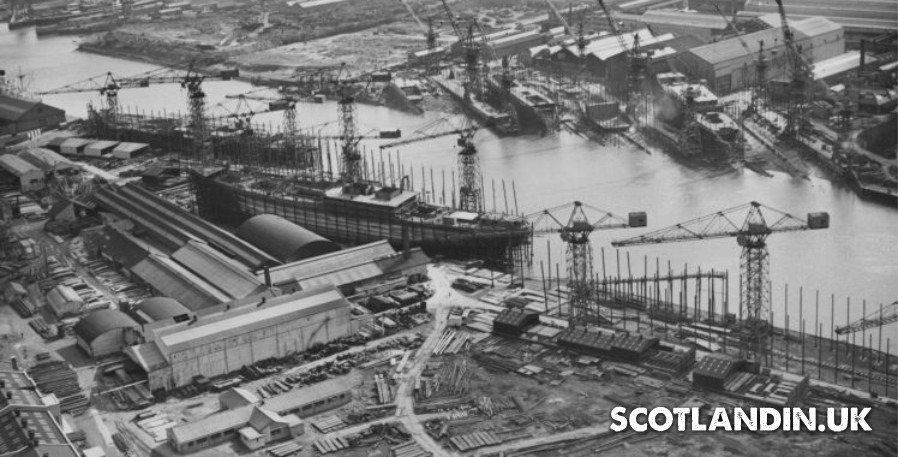
The Industrial Revolution brought significant changes to Glasgow. The city’s industrial growth, emergence of key industries, urban expansion, social reforms, cultural advancements, and architectural transformation all shaped Glasgow into the vibrant and diverse city it is today.
Industrial Transformation of Glasgow
Glasgow, once a small town, underwent a remarkable transformation during the Industrial Revolution. The city experienced a surge in industrial activity and became a thriving center for various industries.
Emergence of Industries
The Industrial Revolution brought about the emergence of several industries in Glasgow. Textile manufacturing, shipbuilding, engineering, iron production, and steel manufacturing became the pillars of the city’s industrial growth.
The Cotton Industry
Glasgow played a significant role in the cotton industry during the Industrial Revolution. Cotton mills and factories proliferated along the banks of the River Clyde, turning the city into a major hub for cotton spinning and weaving.
Shipbuilding and Maritime Trade
The Industrial Revolution propelled Glasgow’s shipbuilding industry to new heights. The city’s shipyards along the Clyde River gained international recognition for constructing steamships, ironclads, and later, luxurious ocean liners.
Urban Expansion
The population of Glasgow skyrocketed during this period, mainly due to the influx of people seeking employment opportunities in the expanding industries. The city underwent extensive urban expansion, with new neighborhoods, tenements, and public infrastructure being developed to accommodate the growing population.
The Industrial Revolution created new employment opportunities, particularly in factories and mines. Many rural workers migrated to urban areas to work in industries, contributing to the growth of the working class. However, working conditions were often harsh, with long hours, low wages, and dangerous working environments.
Environmental Consequences
The Industrial Revolution brought significant environmental challenges. Pollution from factories and mining activities affected air and water quality. The expansion of industrial infrastructure also resulted in the destruction of natural habitats and landscapes.
Living Conditions and Challenges
The rapid urbanization brought challenges to Glasgow. Overcrowding and poor living conditions were prevalent, especially among the working class. Tenement housing became the norm, often leading to cramped and unsanitary living conditions.
The rapid growth of industries led to mass urbanization, with people flocking to cities in search of employment opportunities.
Glasgow, in particular, saw a significant population increase as it became a major industrial center. Urban areas expanded rapidly, resulting in crowded living conditions and the development of tenements to accommodate the growing population.
Infrastructure Development
To support its industries and growing population, Glasgow invested in infrastructure development. The city improved its transportation networks, constructing canals and expanding the railway system, facilitating the movement of goods and people and further stimulating economic growth.
Scotland witnessed significant infrastructure development during this period. Canals were constructed to improve transportation and facilitate the movement of goods. The expansion of the railway network further connected different regions, allowing for the efficient transport of raw materials and finished products.
Social Reforms and Movements
The Industrial Revolution in Glasgow triggered social reform movements. Workers’ rights movements and trade unions gained momentum as laborers sought improved working conditions and fair treatment. Influential figures emerged to advocate for political and social change.
The Industrial Revolution exacerbated social inequalities. While the industrial elite prospered, the working class faced challenging living conditions, low wages, and limited access to basic amenities. This led to social unrest and the emergence of labor movements and trade unions advocating for workers’ rights.
Cultural Advancements
Amidst the industrial growth, Glasgow also experienced cultural advancements. The city became a center for education and intellectual pursuits. The University of Glasgow thrived, attracting scholars and fostering a culture of learning. Museums, libraries, and cultural institutions were established, contributing to the city’s cultural heritage.
The Scottish Enlightenment, which preceded the Industrial Revolution, fostered intellectual and scientific advancements. Scotland became known for its influential thinkers, scholars, and inventors who contributed to fields such as philosophy, economics, and engineering.
Architectural Transformation
Glasgow’s industrialization had a profound impact on its architectural landscape. Renowned architects like Charles Rennie Mackintosh emerged, bringing modern design principles to buildings and structures. Glasgow developed its distinct architectural style, known as the Glasgow Style, which showcased creativity and artistic expression.
Economic Evolution
While Glasgow enjoyed economic prosperity during the Industrial Revolution, it also faced challenges in later years. Increased competition from other industrial centers, shifts in global trade patterns, and the decline of traditional industries impacted the city’s economy. However, Glasgow later reinvented itself as a center for commerce, finance, and culture.
Technological Advancements
The Industrial Revolution brought about technological advancements that revolutionized various industries. Scotland played a significant role in engineering and innovation, with notable inventions such as James Watt’s steam engine and improvements in textile machinery. These advancements fueled industrial growth and productivity.
Agricultural Changes
As industries boomed, agricultural practices changed. Many rural communities experienced a decline as people migrated to cities for work. The shift from traditional farming methods to large-scale commercial farming and enclosure of land had a profound impact on rural life and traditional agricultural practices.
The legacy of the Industrial Revolution can still be seen in Glasgow’s architectural heritage, cultural institutions, and industrial legacy sites that bear witness to its remarkable journey of transformation.
In summary, the Industrial Revolution had a transformative impact on Scotland. It led to industrialization, urbanization, technological advancements, and infrastructure development. It also brought about social disparities, environmental challenges, and cultural and intellectual influence.
Today, the legacy of the Industrial Revolution can still be observed in Scotland’s industrial heritage, urban landscape, and contributions to science, engineering, and culture.